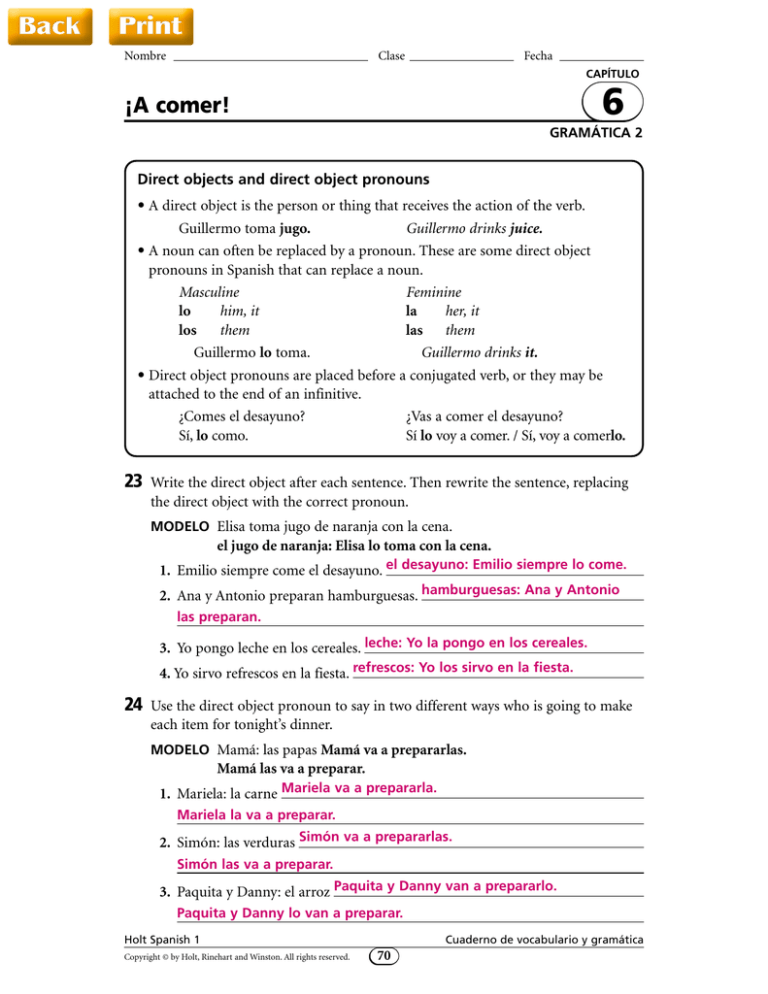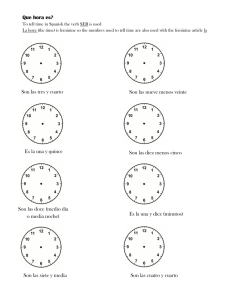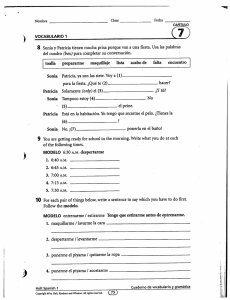¡A comer!
Anuncio

Back Print Nombre Clase Fecha CAPÍTULO 6 ¡A comer! GRAMÁTICA 2 Direct objects and direct object pronouns • A direct object is the person or thing that receives the action of the verb. Guillermo toma jugo. Guillermo drinks juice. • A noun can often be replaced by a pronoun. These are some direct object pronouns in Spanish that can replace a noun. Masculine Feminine lo him, it la her, it los them las them Guillermo lo toma. Guillermo drinks it. • Direct object pronouns are placed before a conjugated verb, or they may be attached to the end of an infinitive. ¿Comes el desayuno? ¿Vas a comer el desayuno? Sí, lo como. Sí lo voy a comer. / Sí, voy a comerlo. 23 Write the direct object after each sentence. Then rewrite the sentence, replacing the direct object with the correct pronoun. MODELO Elisa toma jugo de naranja con la cena. el jugo de naranja: Elisa lo toma con la cena. 1. Emilio siempre come el desayuno. el desayuno: Emilio siempre lo come. 2. Ana y Antonio preparan hamburguesas. hamburguesas: Ana y Antonio las preparan. 3. Yo pongo leche en los cereales. leche: Yo la pongo en los cereales. 4. Yo sirvo refrescos en la fiesta. refrescos: Yo los sirvo en la fiesta. 24 Use the direct object pronoun to say in two different ways who is going to make each item for tonight’s dinner. MODELO Mamá: las papas Mamá va a prepararlas. Mamá las va a preparar. 1. Mariela: la carne Mariela va a prepararla. Mariela la va a preparar. 2. Simón: las verduras Simón va a prepararlas. Simón las va a preparar. 3. Paquita y Danny: el arroz Paquita y Danny van a prepararlo. Paquita y Danny lo van a preparar. Holt Spanish 1 Copyright © by Holt, Rinehart and Winston. All rights reserved. Cuaderno de vocabulario y gramática 70 Back Print Nombre Clase Fecha CAPÍTULO 6 GRAMÁTICA 2 Affirmative informal commands • Use affirmative informal commands when you want to give instructions to someone that you would address with the tú form. • To form this type of command, drop the final s from the present-tense tú form. Present-tense tú form Affirmative informal command tú hablas you speak habla speak tú escribes you write escribe write tú pides you ask for pide ask for Pide un huevo para el desayuno. Ask for an egg for breakfast. • The affirmative informal command is irregular in certain verbs: tú tienes (ten), tú vienes (ven), tú pones (pon), tú vas (ve), tú eres (sé), tú haces (haz), and tú sales (sal). • Below are some verbs you might use in the kitchen. tú calientas you heat calienta heat tú sacas you take out saca take out tú cortas you cut corta cut tú abres you open abre open tú mezclas you mix mezcla mix 25 Lola wants to throw a party, but she needs help. Tell her friends what to do by answering their questions with informal commands. Answers will vary. MODELO ¿Escribo invitaciones para mis amigos? Possible answers: Sí, escribe invitaciones para tus amigos. 1. ¿Pongo las sillas en el comedor? Sí, pon las sillas en el comedor. 2. ¿Voy al mercado (market) hoy? Sí, ve al mercado hoy. 3. ¿Vengo temprano para ayudar? Sí, ven temprano. 4. ¿Qué postre hago? Haz el flan. 5. ¿Pido ayuda para organizar la fiesta? Sí, pide ayuda para organizar la fiesta. 26 Raúl is about to start preparing dinner. Tell him four things he should do using affirmative informal commands. Answers will vary. Possible answers: MODELO mezclar Mezcla el jugo. 1. calentar Calienta el horno. 2. sacar Saca los refrescos del refrigerador. 3. cortar Corta el pan. 4. abrir Abre el refrigerador. Holt Spanish 1 Copyright © by Holt, Rinehart and Winston. All rights reserved. Cuaderno de vocabulario y gramática 71 Back Print Nombre Clase Fecha CAPÍTULO 6 GRAMÁTICA 2 Affirmative informal commands with pronouns • In a statement, remember to use the direct object pronouns either before the conjugated verb or attached to the end of the infinitive. Lo hago por la tarde. Lo voy a hacer por la tarde. Voy a hacerlo por la tarde. • In an affirmative informal command, always attach the direct object pronoun to the end of the verb. Hazlo esta tarde. Do it this afternoon. • Unless the command is one syllable, you must add a written accent on the stressed vowel. Hazlo. (no accent) Cómela. (accent added) Do it. Eat it. 27 Roberta is in charge of dinner tonight. Write her affirmative informal commands with the appropriate direct object pronoun attached. Don’t forget to add an accent mark if needed. MODELO calentar los pasteles Caliéntalos. Mézclalas. 1. mezclar las ensaladas 2. sacar el pollo del horno 3. poner los platos 4. abrir las ventanas 5. probar el arroz 28 Sácalo del horno. Ponlos. Ábrelas. Pruébalo. Help your friend live a healthier life by answering her questions. Use affirmative informal commands. Whenever possible, use direct object pronouns also. 1. ¿Debo ir a la cama temprano? Sí, ve a la cama muy temprano. Answers may vary. Possible answers: 2. ¿Necesito comer frutas y verduras? Sí, cómelas. 3. ¿Hago la tarea por la tarde o por la noche? Hazla por la tarde. 4. ¿Salgo a pasear en el sol a veces? Sí, sal a pasear en el sol a veces. 5. ¿Debo ser disciplinada (disciplined)? Sí, sé disciplinada. Holt Spanish 1 Copyright © by Holt, Rinehart and Winston. All rights reserved. Cuaderno de vocabulario y gramática 72


